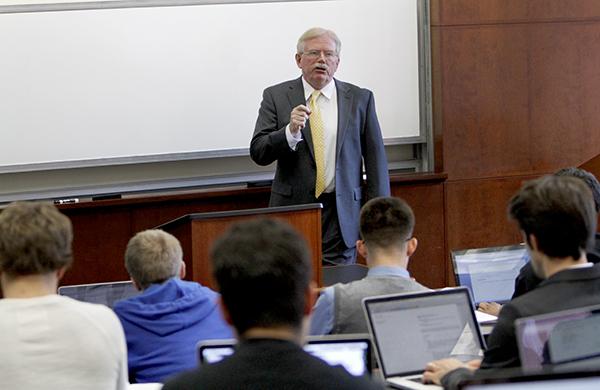Updated: Sept. 19, 2014 at 10:38 a.m.
The law school is creating a road map for how it can lure new students with more innovative programs as it looks to thrive in a struggling legal job market.
A roughly 15-person committee, consisting of faculty, associate deans and one student, is planning new ways to help graduates land jobs, increase the number of hands-on learning opportunities and improve training for faculty so they can better prepare students for employment.
Roger Trangsrud, a professor who is leading the planning committee, said the group aims to lay out how the No. 20 law school can tackle challenges facing law schools across the country, such as declining enrollment and low job placement among graduates.
“[We are] not expecting to find any magic bullet that will make our problems go away, but instead look at all aspects of the school and how it works. We want a comprehensive assessment of what we can do better,” he said.
The group hopes to complete its process by about the time the American Bar Association visits the school in spring 2016 for its seven-year accreditation review.
Since spring 2013, committees have completed nearly 20 reports about how to improve the school, including its library, clinics and career development, Trangsrud said. Those reports will guide the remainder of the school’s planning, and several professors will discuss them over the next few weeks with Blake D. Morant, the school’s new dean who arrived on campus this month.
Nationally, law schools have seen fewer prospective students apply every year, and many of GW’s peer schools have shrunk their class sizes to match the lower demand.
GW increased the size of its first-year class last fall by more than 80 students, which came after the school accepted about 100 fewer students than usual in fall 2013.
Paul Campos, a law professor at the University of Colorado at Boulder and author of the book “Don’t Go to Law School (Unless),” said many professors across the country now working as professors have not practiced law for years. That can limit the kind of knowledge they can pass on to students, and is one area GW hopes to strengthen.
“We need to help new students to make adjustments from college to being a professional lawyer, because there’s a whole set of professional skills that are important to the practice of law,” Trangsrud said.
As the committee starts working with Morant, it will consider some of the programs he led at his previous school. For the last seven years, Morant served as dean of the Wake Forest University School of Law, which offers courses in specific areas of law to students who only want a taste of legal education.
Courses could include business, contract or human resources law. Campos said many schools, typically outside the nation’s circle of elite institutions, are launching similar programs to make up for the loss of revenue as enrollment continues to fall.
“These lower-ranked schools are wondering how they are going to survive. If you’re under pressure, you’re much more likely to figure out how to do something different,” Campos said.
Several professors have said in the last year that the school wants to emphasize its status as one of the five largest law schools in the country.
While the school increased its class size this year, it saw the average LSAT score drop by two points. The school’s acceptance rate rose to 42 percent, and its yield rate – the number of students who accepted offers of admission – fell to 16.7 percent.
Trangsrud said the committee is looking to be cost conscious as they revamp some of the school’s programs. Updates such as offering more hands-on experience can be cost neutral, he said. But other ideas like increasing the number of students in the Pathways to Practice program, which pays students to work unpaid jobs or internships after graduation, will require more spending.
The school has historically spent about $3 million annually on the Pathways to Practice program, which raises the number of students the University can report as employed to the American Bar Association each year.
John Banzhaf, who began teaching at the law school in 1968, said preparation for accreditation is one way the school can start internal conversations about how to improve.
“Our law school, like any other law school is always planning something,” he said.
This post was updated to reflect the following corrections:
The Hatchet incorrectly reported that the law school’s strategic planning committee was making the plan for its accreditation review. It actually hopes to finish its work by the time of the review, though the two are not related. Due to an editing error, the Hatchet incorrectly spelt Roger Trangsrud’s name and ranked the GW Law School as No. 21 on the U.S. News and World Report’s list. It is actually tied for No. 20. We regret these errors.








